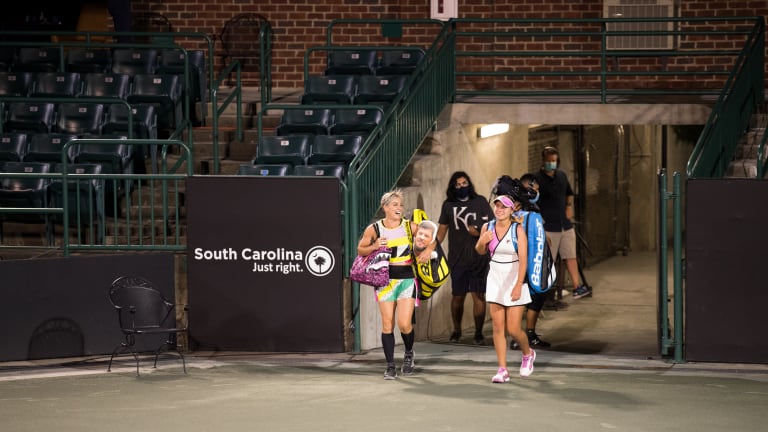American Dreamer: Can Sofia Kenin pick up where she left off?
By Steve Tignor Aug 23, 2020Leylah Fernandez deals Jessica Pegula opening exit in Washington ahead of key stretch
By TENNIS.com Jul 25, 2025Roland Garros Betting Preview: Sofia Kenin vs. Madison Keys
By Zachary Cohen May 30, 2025Jessica Pegula fights through fatigue to win Charleston title against Sofia Kenin
By TENNIS.com Apr 06, 2025Charleston Betting Preview: Sofia Kenin vs. Jessica Pegula
By Zachary Cohen Apr 06, 2025Quote of the Day: Coco Gauff “really wanted the 6-0” as she closed out Miami demolition
By Stephanie Livaudais Mar 21, 2025Coco Gauff vs. Sofia Kenin: Where to Watch, Miami Open Preview, Betting Odds
By Steve Tignor Mar 19, 2025Joao Fonseca, Coco Gauff and Naomi Osaka all in action: Miami, Day 3 Preview
By Steve Tignor Mar 19, 2025Elena Rybakina vs. Sofia Kenin: Where to Watch, Dubai Preview, Betting Odds
By TENNIS.com Feb 19, 2025Dubai Betting Preview: Sofia Kenin vs. Elena Rybakina
By Zachary Cohen Feb 19, 2025American Dreamer: Can Sofia Kenin pick up where she left off?
The former top prospect turned Australian Open champion has too many goals, for herself and for the red, white and blue, to slow down now.
Published Aug 23, 2020
Advertising
This story was featured in the September/October issue of TENNIS Magazine. For a year-long subscription, featuring exclusive interviews, expert instruction content and more, click here.
Trying to interview a famous athlete today can be a Kafka-esque process, one filled with delicate negotiations and maddening delays—and that’s if you’re lucky enough to get a response in the first place. But Sofia Kenin is not your stereotypical famous athlete. When the 21-year-old Floridian says she’ll call you at 11:00 to talk, she calls you at 11:00 to talk. Not 10:59. Not 11:01. 11:00 on the dot. And when she says, “Hi, this is Sofia Kenin,” she sounds exactly the way she does in public: Upbeat, down to earth, ready to go.
More than ready, in fact. When I talked to Kenin this summer, she had just finished playing her first match in months, at the Credit One Bank Invitational in Charleston, S.C. There were no fans in the stands or ranking points on the line, but Kenin didn’t mind. Like many of us, she’d had her fill of the quarantine, the news on TV, the recipes she was trying to master to pass the time, and the practice court.
“I play way better in matches anyway,” Kenin laughs. “Of course you miss the fans screaming, but I tried to forget about everything for a little bit.”
If anyone had a reason to rue the coronavirus and the havoc it has wreaked, it’s Kenin. In January, with virtually no warning, she won the Australian Open. She was seeded 14th, and had never reached a Grand Slam quarterfinal. But in her last two matches, when she faced major-title winners Ashleigh Barty and Garbine Muguruza, Kenin played with the blend of bravery and sagacity that we normally associate with veteran champions.
Unlike other young breakthrough performers of recent years, Kenin didn’t show any signs of buckling under the weight of new expectations or being distracted by the duties of celebrity. The day after winning in Melbourne, she happily donned a silver designer dress for her photo shoot with the trophy. “I love all this attention and this media!” she said. And then she went back to business. Debuting as her country’s top-ranked player the following weekend, Kenin helped the U.S. Fed Cup team win a tie over Latvia, and a month later, she won the WTA tournament in Lyon. “Yeah, I thought maybe I was going on a roll,” Kenin says with a sigh.

American Dreamer: Can Sofia Kenin pick up where she left off?
Advertising
At the Australian Open, Kenin beat just one seeded player en route to victory—but it was the No. 1 seed, Ashleigh Barty. She also topped strong unseeded players Coco Gauff and Garbine Muguruza. (Getty Images)
How did she handle having her breakout season shut down? She did what it seems she has always done: she kept things simple, positive, and realistic, and listened to the calming advice of her father and coach, Alex.
“He told me not to be down, to keep practicing, and the tour will open up eventually,” Kenin says, after rising to No. 4 in the world rankings. “I just spent time with my family, and made sure I stayed healthy. There wasn’t much else to do, and it’s good to be with family.”
From her home north of Miami, Kenin saw coronavirus cases fall and rise again this summer, in Florida and around the country. She said that being able to hit on a nearby private court helped her stay sane.
“It’s not easy to focus in practice when you don’t have any matches coming up,” Kenin says. “Some players lose motivation, but going to the court every day helped me.”
Motivation has never been a problem for the Kenin family. Even before Australia, their story was the stuff of old-fashioned American dreams. In 1987, Alex and his wife, Svetlana, moved from the Soviet Union to New York with $300. Alex drove a cab at night, trying his best to make out the dispatcher’s instructions as he learned English. After relocating to Florida, he introduced 3-year-old Sofia to tennis in their driveway. From her first swing, there was something uncanny about the way she timed the ball.
“Sofia was the scariest little creature I’d ever seen,” Rick Macci, her first coach, told the New York Times. “It was unique: the hand-eye coordination and her ability to take the ball immediately after the bounce. I have a lot of kids who do that, but [with her] it was almost like it was baked in already.”
The pint-sized Cinderella soon found herself hitting against one of her idols, Anna Kournikova, playing doubles with John McEnroe, and charming audiences at Florida charity events. But Kenin was more than just a freaky ball-striking machine. She also had a precocious grasp of the game. At an event in 2005, a six-year-old Kenin was asked if she thought she could return Andy Roddick’s 140-m.p.h. serve. After saying “Yes”— naturally—she explained how: “If I split step and prepare early and I do a short backswing.” A teaching pro couldn’t have said it better.
“I understood everything at that age,” Kenin said with a laugh last year.
Sofia Kenin InterviewSonya Kenin is into the Australian Open Final. But can she return Roddick's serve. At 7 years old, she thought yes. 😉
Posted by TENNIS.com on Wednesday, January 29, 2020
Advertising
Kenin was ranked No. 1 in the U.S. in the 10s, 12s, 14s, 16s and 18s, and she reached the final of the US Open girls’ tournament in 2015. But a question lingered: at 5’7”, would she have the power to compete with the pros?
After beating Kenin in the third round at the Open in 2017, another of her idols, Maria Sharapova, described her as a “grinder.” Sharapova meant it as a compliment, but the word also comes with a negative connotation: A grinder is a player with limitations.
“Those people who didn’t believe in her, they had very valid reasons not to,” Alex Kenin told reporters in Australia this year, “because she has always been the smallest one. Thank God I saw something that they didn’t because I know her better.”
What Alex knew was that his daughter had never failed to “amaze” him. She wouldn’t fail him this time, either. Throughout 2017, he watched as Sofia became more aggressive and raised her game to match her professional competition. “She looks very focused,” he told the SunSentinel in 2018. “She had very good matches. She competed very well.”
Kenin validated her dad’s faith in 2019, when she rose from outside the Top 50 to the brink of the Top 10. She won three titles, including one on grass, and upset Serena Williams at Roland Garros. Kenin showed that the combination that had worked so well for her as a junior—good hands, creative tactics, measured aggression, unshakeable determination— could also work at the adult level.
“She does such a great job of holding her ground,” Tracy Austin said in Charleston. “Her timing, her balance, her ability to hit the ball on the rise, so she doesn’t need to back up. She’s always purposeful with every swing, trying to widen the court with angles.”
Bethanie Mattek-Sands, a Fed Cup teammate of Kenin’s, has used David Ferrer’s old nickname, “Little Beast,” to describe her. But like Ferrer, there’s more to Kenin’s game than dogged persistence. Drop shots, angles, lobs, volleys: she hits them all well, especially from the backhand side—Mattek-Sands calls Kenin’s topspin lob “dirty”—and she has a knack for choosing the right tactic at the right moment.
Just as important, Kenin doesn’t sabotage herself emotionally. In the Australian Open final, she worked herself into a state that might be called Furious Zen. She was mad, but not negative; fearless, but not reckless.
“She was down 0–40 on her serve, 2–2 in the third, and came up with five consecutive winners,” Austin said, referring to the now-legendary barrage that sank Muguruza. “That reminded me of Monica Seles. She went for her shots regardless of the score.”
Yet even as Kenin’s ranking rose in 2019, the attention paid to her didn’t. Coming into 2020, 15-year-old Coco Gauff was the talk of American tennis—not without reason. While praising Gauff as a player and person, Alex Kenin told TENNIS.com in Melbourne, “I think hype should equal accomplishments and that would be fair. It’s regarding to my daughter comparing the amount of coverage she has, and she has accomplished much more.”
Again, Sofia made her father look prescient by beating Gauff on her way to the title. By tournament’s end, the eyes of the tennis world were on Alex, as he anxiously cringed and squirmed and covered his eyes with his hands while watching his daughter in Rod Laver Arena.
“My dad plays every point with me,” Sofia says. “He sees the game so well, and knows exactly what to say to make me play better.”

American Dreamer: Can Sofia Kenin pick up where she left off?
Advertising
Kenin, No. 4 in WTA singles when play stopped in March, made her return to competition in June at the Credit One Bank Invitational, where she played doubles with Bethanie Mattek-Sands. (Credit One Bank Invitational)
American tennis fans may have been looking elsewhere for a new star at the start of the year, but Kenin is happy to represent them. Her family’s story has echoes of Kournikova’s and Sharapova’s, who both moved from Russia to Florida. Unlike them, though, Kenin plays for the U.S., and dreams of bringing a Fed Cup title and Olympic medal home.
“They gave me the American Dream,” Kenin said of her parents. “I’m proud of it and thankful for them.”
Kenin is such a lover of the red, white, and blue that she played with a Babolat racquet that was painted those colors in Australia.
“They said, ‘Do you want to be the girl representing America, having an American racquet?’” Kenin said. “I was like, ‘Hell yeah, I want to.’”
Not surprisingly, Kenin was disappointed when the Olympics and Fed Cup Finals were canceled for 2020. In June, she said she was “all in” on playing the US Open, provided “it can be safe.”
As for whether she’ll be able to pick up where she left off, Kenin has come too far to slow down now that all of her many dreams—her American dreams, her dreams of being in the spotlight, her dreams of winning majors—are coming true. Even during the long lockdown and the fanless events that followed, Kenin didn’t forget what the applause Down Under sounded like.
“I still have the confidence from what happened in Australia,” she says. “Winning a Grand Slam isn’t something you forget.”
As our phone conversation ends and the rest of the 2020 season, hopefully, beckons, Kenin sounds just the way she did when it began: Upbeat, down to earth, ready to go.

American Dreamer: Can Sofia Kenin pick up where she left off?